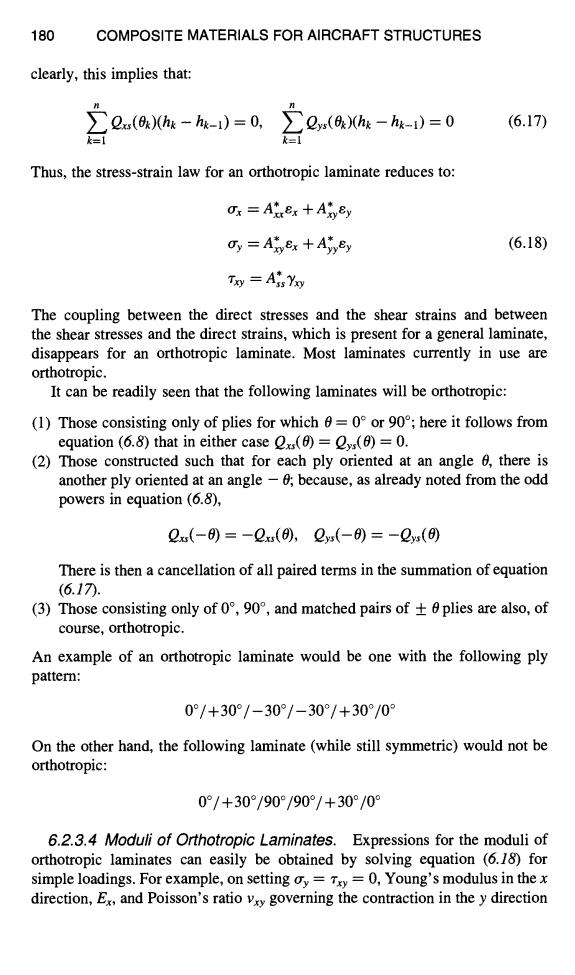正在加载图片...

180 COMPOSITE MATERIALS FOR AIRCRAFT STRUCTURES clearly,this implies that: ∑2a()hk-hk-i)=0, >Qys(0k)(hg-hg-1)=0 (6.17) k=1 Thus,the stress-strain law for an orthotropic laminate reduces to: x=At8x+A刘Ey Oy Atyex +Ayyey (6.18) Txy =Ais Yo The coupling between the direct stresses and the shear strains and between the shear stresses and the direct strains,which is present for a general laminate, disappears for an orthotropic laminate.Most laminates currently in use are orthotropic. It can be readily seen that the following laminates will be orthotropic: (1)Those consisting only of plies for which 6=0 or 90;here it follows from equation (6.8)that in either case ()=vs(6)=0. (2)Those constructed such that for each ply oriented at an angle 6,there is another ply oriented at an angle -0;because,as already noted from the odd powers in equation(6.8), 2x(-)=-Qxx(),Qyx(-)=-2s(0 There is then a cancellation of all paired terms in the summation of equation (6.17). (3)Those consisting only of 0°,9o°,and matched pairs of±0 plies are also,.of course,orthotropic. An example of an orthotropic laminate would be one with the following ply pattern: 0°/+30°/-30°/-30°/+30°/0 On the other hand,the following laminate (while still symmetric)would not be orthotropic: 0°/+30°/90°/90°/+30°/0° 6.2.3.4 Moduli of Orthotropic Laminates.Expressions for the moduli of orthotropic laminates can easily be obtained by solving equation (6.18)for simple loadings.For example,on setting oy=Txy=0,Young's modulus in the x direction,E,and Poisson's ratio vxy governing the contraction in the y direction180 COMPOSITE MATERIALS FOR AIRCRAFT STRUCTURES clearly, this implies that: n Qxs(Ok)(hk -- hk-l) = O, k=l ~-~ Qys( Ok)(hk -- hk-1) = 0 (6.17) k=l Thus, the stress-strain law for an orthotropic laminate reduces to: O'x = Axxex + Axysy O'y = Axy ex + Ayy ~y (6.18) Txy = A,* Yxy The coupling between the direct stresses and the shear strains and between the shear stresses and the direct strains, which is present for a general laminate, disappears for an orthotropic laminate. Most laminates currently in use are orthotropic. It can be readily seen that the following laminates will be orthotropic: (1) Those consisting only of plies for which 0 = 0 ° or 90°; here it follows from equation (6.8) that in either case Qxs(O) = Qys(0) = 0. (2) Those constructed such that for each ply oriented at an angle 0, there is another ply oriented at an angle - 0; because, as already noted from the odd powers in equation (6.8), Qxs(-O)=-Qxs(O), Qys(-O)=-Qys(O) There is then a cancellation of all paired terms in the summation of equation (6.17). (3) Those consisting only of 0 °, 90 °, and matched pairs of + 0 plies are also, of course, orthotropic. An example of an orthotropic laminate would be one with the following ply pattern: 0°/+30°/-30°/-30°/+30°/0 ° On the other hand, the following laminate (while still symmetric) would not be orthotropic: 0°1+30°190°190°1+30°/0° 6.2.3.4 Modufi of Orthotropic Laminates. Expressions for the moduli of orthotropic laminates can easily be obtained by solving equation (6.18) for simple loadings. For example, on setting try = "rxy = 0, Young's modulus in the x direction, Ex, and Poisson's ratio Vxy governing the contraction in the y direction